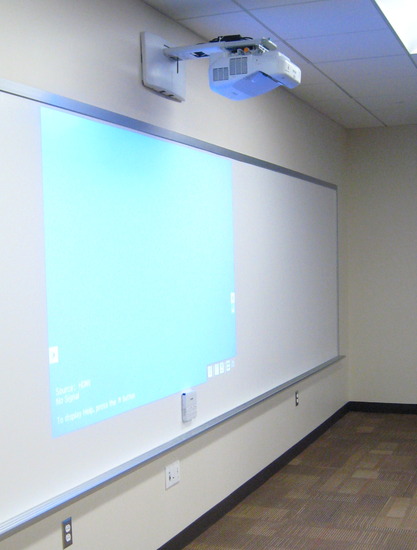Short Throw Interactive Projector
Overview
Overview of the Epson Brightlink Interactive short throw projector.
Features
This projector displays a digital image onto a wall, table, floor, ceiling, or other surface, but primarily on the IWU campus, it will be installed on the wall above a whiteboard (dry erase markerboard). It functions the same as a typical data/video projector, with an HDMI input for connecting a laptop, document camera, microscope, or other device, and projecting the image onto the whiteboard.
Then, for the interactive part, the user can use a stylus-like pen to annotate over top of the projected image. For more information on this feature, click here.
Some projectors are connected to the teaching station, so all of the devices that can be selected by the touch panel can also be viewed on the whiteboard. In this case, the pen can also function as a mouse, selecting items on the computer (icons, tools, files), even right-clicking, and even enabling a virtual keyboard and handwriting recognition.
Other projectors are configured for stand-alone mode, and are not connected to the teaching station. In this case, the projector has built-in annotation features, whiteboard features, and when a user connects their laptop to a stand-alone interactive projector, and if they have they have Epson Easy Interactive Software installed on that laptop, and if they have a USB cable connecting their laptop to the projector, then the pens can function as a mouse, and the user can save their annotations back to their laptops as .jpg or .pdf files.
Stand-alone interactive projectors may have a wall-mounted control panel, or keypad. It will be located near the projector, and have a power button for turning the projector On or Off, a Whiteboard mode button, and a Save button for saving the annotations to a jpg or pdf file. For the purpose of saving files, a laptop can be connected with a standard USB cable to this control panel, or a USB thumb drive can be connected to the control panel. In some rooms with multiple projectors, an HDMI connection beneath the interactive projector, allows an instructor, or a group of students to cluster around the interactive projector, connect their tablet or laptop, and then annotate over the projected image from that laptop.
Tips
Some projectors may have a wireless remote control for use with the projector. For more information on this projector, click here.

